Background and History
The White Pine silver rush at Hamilton and Treasure Hill was in full swing by 1870, barely 2 years old. It attracted miners and prospectors from all over America, particularly the African American community from the California bay area as evidenced in the Elevator newspaper which promoted black business.
There is no Joseph T. Kennedy in the census of 1870. There were several Joseph Kennedy’s in Nevada during this period as well as virtually dozens more with different first names, all Irish immigrants. The inference here is that Joseph T. Kennedy was traveling to Hamilton and acquired the ingot as a personal souvenir. It would have been a high-priced souvenir, perhaps given to his wife. The photo is of a young man perhaps 30-35 years of age and where he went after Hamilton is a mystery. One clue was found in the 1871 Langley Pacific Coast Directory listing J. M. Kennedy and F. H. Kennedy as attorneys in Hamilton, with their office at the White Pine County courthouse. Neither of these two men are listed in the 1870 US Census, a possible indication that parts of this remote area in eastern Nevada were missed by the census takers, which was not uncommon at the time. James Kennedy was an attorney in Pioche that year, also shown in the 1871 Directory. The possibility exists that the well dressed gentleman subject this ingot was a relative of the three Kennedy’s (or two, if J.M. and James are the same person) from Hamilton and Pioche. The possible coincidence of names is impossible to ignore, as is the expense of this ingot in its construction. We thus assume our Kennedy here is a relative of the attorneys at Hamilton.
This ingot from 1870 was made the same year the great Eberhardt and Aurora Mining Company was formed in London, headed by an assayer from the Royal Mint, E. W. J. Ridsale. Production that year was more than $2.2 million in silver. The year prior, the “Rush to White Pine” was estimated to have brought in 25,000 people, several times more than the great Comstock in the first years there. The huge influx of prospectors was greatly aided by the completion of the Central Pacific Railroad in 1869.
J. T. Kennedy; Hamilton, Nevada Portrait Presentation Silver Ingot, 1870
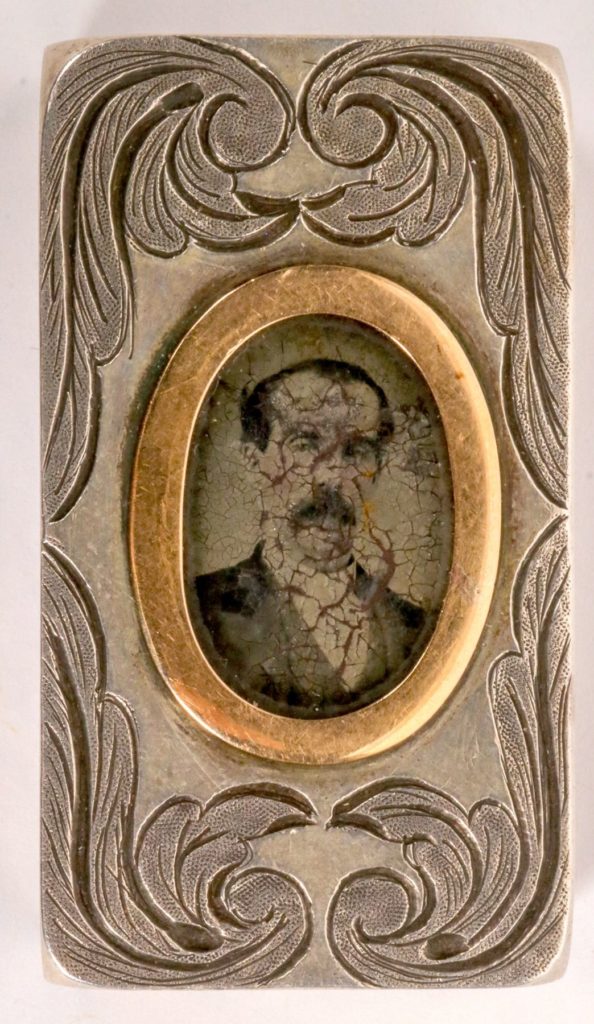
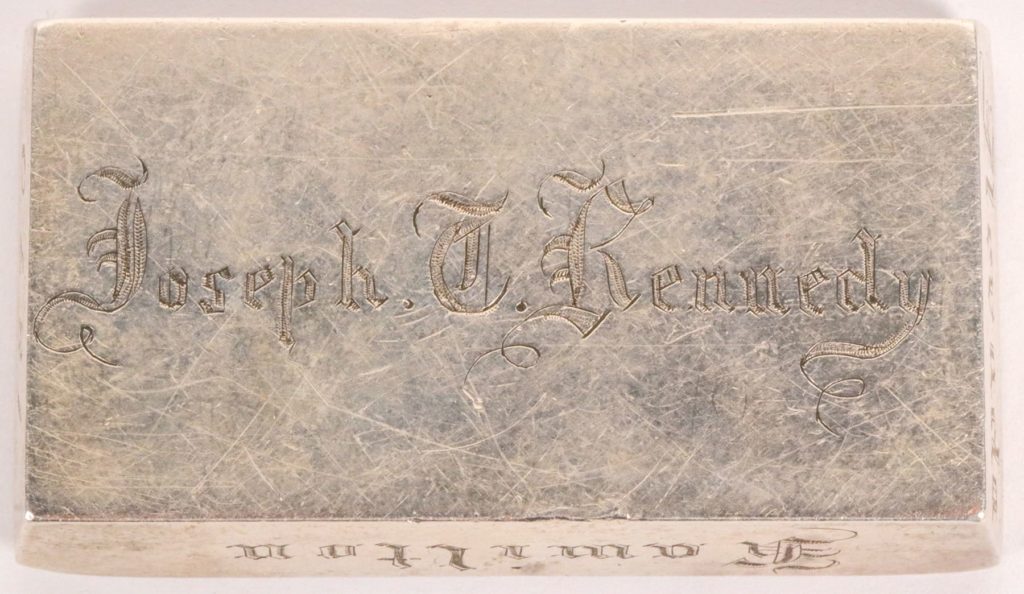

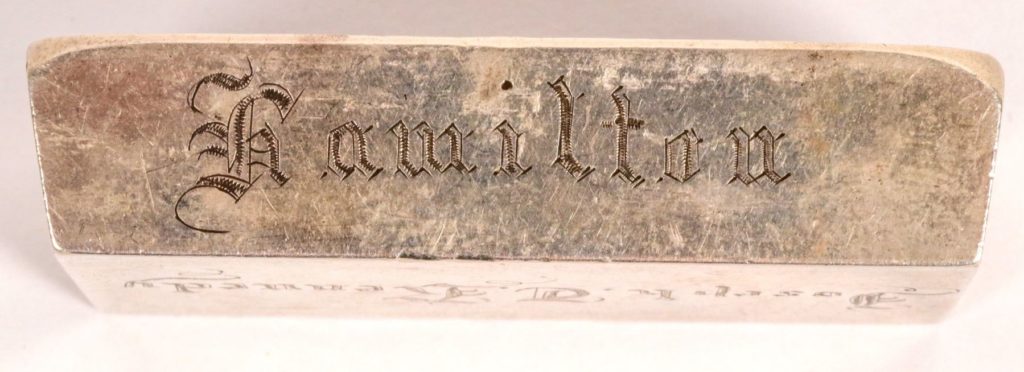
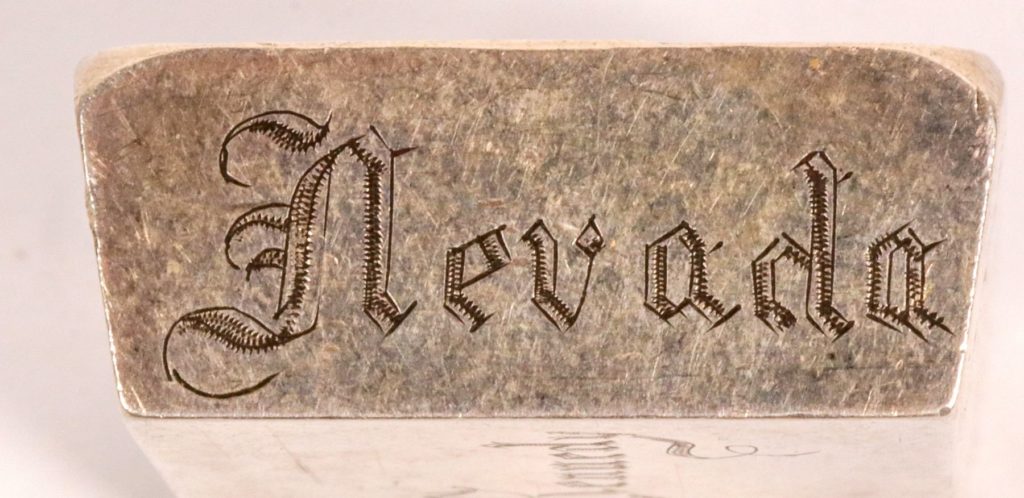
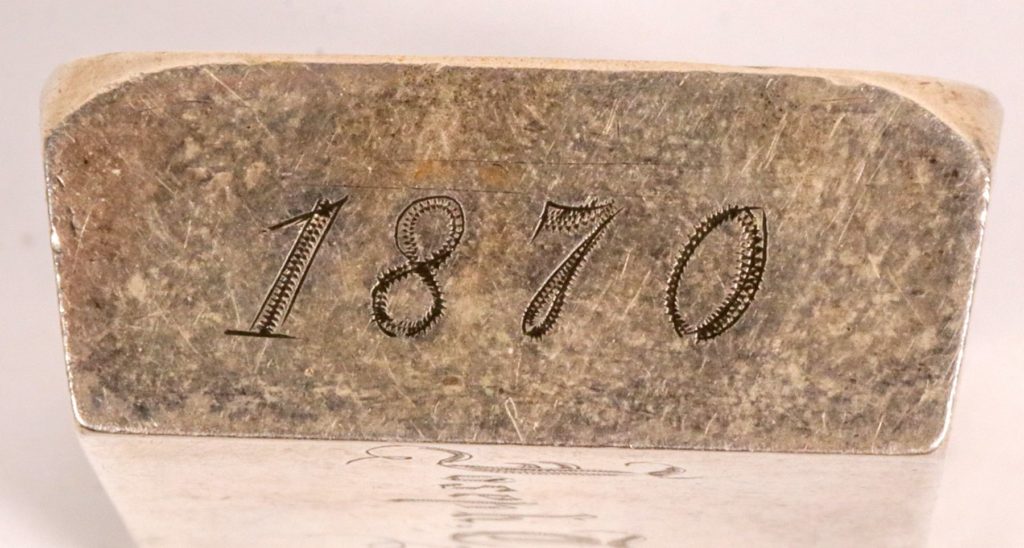
“Joseph T. Kennedy//Hamilton// White Pine// Nevada//1870// tintype portrait of a man 15 x 21.5mm surrounded by 2.5mm, 14kt gold border, framing the man. Ornately engraved patterns around the portrait. Measurements for obverse face: 2-1/16″ long x 1.25″ x 1/2″; reverse: 2″long x 1-1/16” wide. Trapezoidal. Silver. This is one of two surviving special high-quality “presentation” style silver ingots with emplaced original portrait photography made by jeweler William Manning of Hamilton, Nevada, the same man that made a similar ingot in Virginia City in 1876.
This is an unusual silver ingot with an original photograph framed in the obverse. It is marked on all 6 sides from Hamilton, White Pine, Nevada, 1870, Joseph T. Kennedy. It must be assumed the photograph is of Kennedy. This very special silver ingot may have been made as a keepsake for his wife.
Who made the Ingot?
This is an expensively prepared silver ingot. It must have been made by an experienced hand, probably an assayer in conjunction with a jeweler who came up with the idea of a portrait permanently emplaced upon the top surface of a silver ingot. This piece has a gold framed “border” around the glass covered tin type portrait, as well as fancy engraving around the portrait that has a rather specific pattern and style.
The question arises with the Kennedy ingot, “Who made the ingot?”
The silver ingot itself was probably made by an assayer in Hamilton under agreement with a jeweler. Here, as in most western mining camps of the period, there were two basic (specific) types of assayers. One was a public assayer – a person or firm that performed third party, independent assays for all aspects of the mining business, from prospecting to production. A second class of assayer was the mine assayer – the assayer or assayers that worked only for a specific mining company. These assayers were in charge of production related aspects of the mining business and were essential to the success of a producing mining company. They tested head grades of ores coming in to the company’s mill, tested the tails of the coming out of the mills (“waste”,) and also importantly tested the purity of the bullion produced which allowed for monetization of the ingot before it was sent to a Branch Mint, US Assay Office, or bank. One such important mine assayer in Hamilton was Sven Gumbinner, the assayer for the Eberhardt & Aurora company.
In the summer of 1870, there were three public assay firms in Hamilton and one in Shermantown, a few miles away. Van Wyck & Co., who also had offices at Virginia City and Aurora over the last few years was the most prominent of the White Pine assayers at the time, though the company had closed all of their other offices by 1870. With the Bank of California there to help fund mining companies and handle bullion accounts, it makes sense that Van Wyck worked with the Bank of California. Bradshaw & Co. were also in Hamilton, and sold assay supplies as well. T. Cahill & Brothers also ran an independent assay house. Down the road in nearby Shermantown were Leibenau and Janin. This was one of the three Janin brothers, of which two were well known mining engineers on the Comstock and elsewhere.
By the end of 1870, moving into 1871, the Eberhardt and Aurora mine had mined over $2 million, and things at Hamilton exploded, at least temporarily. The assay houses of Meyer & Wertheimer and Moss & Taft were added to the competing assay houses in Hamilton, as were A. Schmolz in Treasure City. Cahill had moved to Treasure City. With the explosion of people to 25,000 in Hamilton and surrounding mining camps, there was plenty of work for all of the assay firms.
The questions of the identity of the jeweler and photographer are also difficult. Three jewelers appear in the 1871 Langley Directory: L. Lebeyrie, William Manning, and A. Strauss. None of these advertised in the local newspaper, the White Pine News. The only photographer to advertise in the White Pine News was Herman Krause, “the old pioneer photographer.” The tax records of that year, however, show three photographers – two of which are neither in the directory or advertised in the newspaper.
While we may never know the true identity of the photographer, some will assume it was Krause. Did Krause come up with the idea of a photograph on an ingot? Or was it a jeweler? I doubt the idea came from an assayer- the concept was new, different, and the last stages of construction of this ingot were too far advanced for either the assayer or the photographer.
Jeweler William Manning makes the Ingot
This silver ingot was engraved and sold by Hamilton jeweler William Manning.
The Secret Revealed
About twenty years ago, another similar ingot appeared in the marketplace. I wrote a story on a silver ingot engraved “Presented to Gertie O. Rugg/ By her friends/ May 25th, 1876”. It was from the Al Bingle Collection. This remarkable ingot was made in nearly the exact same size, style and engraved patterns as the Kennedy ingot here. The Rugg ingot proved to be from Virginia City. It also carried a tin type portrait under a glass cover, surrounded by a border “frame” in silver nearly identical to that of the Kennedy ingot, except not gold or gold plated.
The Kennedy and Rugg ingots are very nearly identical. So far as is known today, there are no other ingots remotely the same, and no other ingots with photographic portraits emplaced upon the top surface of the ingots. Upon close side by side photographic inspection and comparison of the engraved patterns surrounding the portraits, in conjunction with the overall unusual “invention” of a presentation ingot with an original photograph, there is only one conclusion – the two ingots were made by the same person.
A look at the assayers, photographers and jewelers in Hamilton in 1870 compared to the list of these men in Virginia City (and the Comstock overall) in 1876 reveals one – and only one – common thread, jeweler William Manning.`
Manning the Jeweler
William Manning was born in 1844 or 1845 in Ireland. His family emigrated to Methwold, Norfolk, England about 1847, where they were farmers (“agricultural laborer). Methwold is about a two hour drive north of London near the east coast, once known for raising rabbits. In 1869 at the age of 24, Manning boarded the Ship of Antwerp in Liverpool bound for New York, landing on September 15, 1869. Manning must have read the many reports of the White Pine Rush of 1869 in the New York newspapers and decided to go there, probably utilizing the newly completed Central Pacific Railroad, getting off at Elko, and taking the stage or on horseback to the remote mining camp of Hamilton, about ten thousand feet in altitude, high in the mountains – much higher than anywhere he’d ever been, far from anywhere.
The 1870 Census shows Manning rooming with ten other men in a Hamilton boarding house. One of the other men present was Isidor Lebeyrie, a jeweler. Lebeyrie, born in France in 1831, was a trained jeweler. Based upon the property owned in Hamilton in 1870, Lebeyrie must have owned his own building and perhaps the boarding house where Manning lived. This gave the newly arrived Manning the opportunity to train under the older and more experienced French jeweler.
Manning worked with Lebeyrie through perhaps into 1871. Along the way, he took a trip to the Comstock in June, 1870. It must have excited his imagination, because it appears he moved there as things in Hamilton were cooling off about 1873 and 1874 as production from the Eberhardt and Aurora had dropped off precipitously. It is possible he had briefly moved to a nearby silver camp Pioche in 1873, and by the end of 1875 was firmly implanted in the business community of Virginia City as a jeweler and watch dealer. In Virginia City, Manning’s business took off. He became a United States citizen in October, 1876. As Manning’s business grew, so too did his popularity. He became known for his fancy engraved items and unusual engraved prizes, all duly noted in local newspapers, particularly silver items. His store regularly exhibited unique and unusual things.
The Manning jewelry store was robbed in 1881 while Manning was away on a trip to Tahoe with his wife. The pair had just had their first child, a daughter, a year earlier. Taking a fast stage back to Virginia City, Manning and the Sheriff were keen to catch the robbers. Rattlesnake Dick was suspected to be involved, and soon, based on a “tip”, many of the items were recovered in San Francisco. Shortly afterwards, Manning announced he was packing up and moving to San Francisco in mid 1882.
The San Francisco jewelry store was also a hit. He continued engraving fancy silver prizes. In the late 1880s, his wife and daughter were regular guests at various Lake and Napa County resorts. His son, William Manning Jr. worked with him for awhile. He retired sometime around 1900, and died December 23, 1913 in San Francisco.
The Lost Mule and the Assayer
-An 1870 Story from a Hamilton Assayer
Now and then a really interesting and fun story arises from a true life adventure. Such is the case today. While browsing the White Pine News for any information I could find on Mr. Kennedy, I discovered a lost mule.
A pet mule belonging to Cinque Barnes was left in the street yesterday, when he concluded to move off on his own account. But one of our assayers, knowing the animal, caught him by the bridle and led him to the sidewalk, near a Main Street saloon, thinking he would remain there till his owner returned. The assayer then went into the saloon to determine the quality of the bar, and was not a little astonished, on turning suddenly round, to behold the good natured face of the mule intently peering over the counter, for all the world as if he had been invited to take a drink, and he hadn’t refused. But as the cupelling process of the establishment did not oxidize liquors in sufficient quantities for mule drinks, the assayer declined to treat, and the owner of the bar refused to take the only bit the animal had as sufficient collateral. That mule was therefore hustled out, like any other bummer, notwithstanding he had a bit left. (White Pine News, July 30, 1870)
Summary
This is a remarkable silver ingot, unique in the world of Western precious Metal ingots.
[06/2023] https://www.icollector.com/J-T-Kennedy-Hamilton-Nevada-Portrait-Presentation-Silver-Ingot-1870-168016_i49117386 ($13,750)
For a similar portrait presentation ingot also made in White Pine 1870, see: https://rareingot.com/j-g-lee-and-john-lee/
